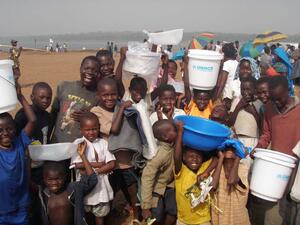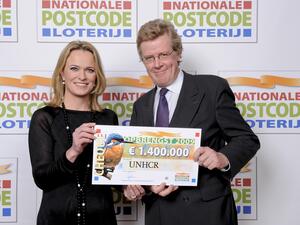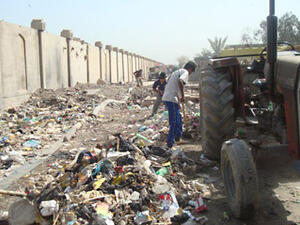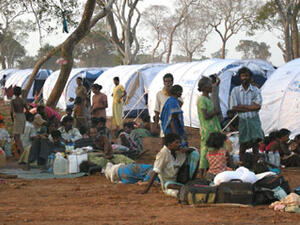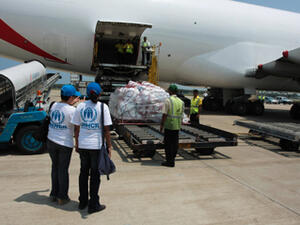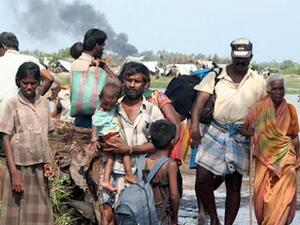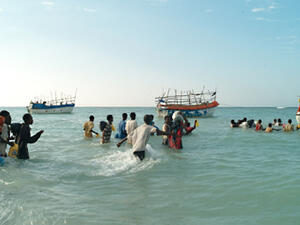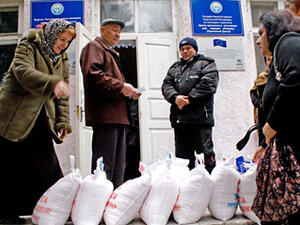Charred village sends message of terror to displaced Darfurians
Charred village sends message of terror to displaced Darfurians

What remains of Seraf, an abandoned village in West Darfur that was burnt to the ground last week. Ceramic pots once used to store grain lay blackened and broken.
SERAF, Sudan, April 26 (UNHCR) - The acrid smell of fresh embers hung in the air and clouds of flies swarmed through the sweltering afternoon air as Ibrahim Adam poked silently through the remains of what had been his grain storage hut. Finally he held aloft a 30-cm steel stake formerly used for tethering his donkey - the blackened piece of metal is all that remains of the life he once led in this Darfur village.
Ibrahim, once a prosperous tailor, led a UNHCR team last week to the freshly torched village of Seraf, an already abandoned village he said was burned to the ground four days earlier by men he calls Arabs or Janjaweed militias.
"They are telling us not to come back to our original village," he said in a voice devoid of emotion. "They want to push us to go to Chad, out of the country. They want to stay here instead of us."
"It's very symbolic," agreed a UNHCR staff member who went to Seraf with Ibrahim. "It's not pragmatic because the village was already empty of people. The message is: 'Don't think life is going to go back to normal.' It is a dramatic way of making the point they (the original inhabitants) are not welcome here."
Last year, during Ramadan, the Islamic holy month from October to November, some 55 abandoned villages were burned around Masteri, an agglomeration of nearly 100 villages 50 km south of El Geneina, capital of West Darfur state. In recent days, the UN refugee agency has received reports that the burning of abandoned villages has resumed.
This development comes as some brave displaced people - about 20,000 out of two million - have taken the chance of going back to resume life in the villages they fled during the conflict that broke out in the Darfur region of western Sudan in February 2003.
This recent spate of arson "is a continuing message - 'Don't even try to come back to your villages to pick up your possessions, collect grass or take up farming again'," said the UNHCR staffer.
As Ibrahim tells the story, the 200 families of Seraf village were chased from their homes a year ago. Some 100 families (perhaps as many as 700 people in a country with large families) went to refugee camps run by UNHCR in neighbouring Chad, some 50 families went to Chad but remained just over the border, and some 50 families moved into Masteri.
Ibrahim took his six-months-pregnant wife, Hailya, to Chad, where she gave birth to a daughter whom they named Salma, which means "safe". On their way back to Darfur a few months later, he said, they were stopped by "Arabs" who forced them to lie on the ground, mocked them as slaves, stole their clothes and made off with the tailor's most valuable possession - his sewing machine. Now he has no way of earning a living.
Along with others in Masteri, Ibrahim spotted smoke last Monday (April 18) and had the horrible feeling it was his village that had been torched. Too frightened to travel by day and risk meeting the Janjaweed, who control the countryside from the backs of their horses and camels, Ibrahim and several other men stole across the countryside by moonlight, trekking a total of 24 km to see what had happened to their homes.
What they found was horrifying. Not a house remained intact. The thatched roofs had dissolved into ash littering the insides of their small mud-brick houses. Huge ceramic pots - the height of a man - once used to store grain lay blackened and broken.
In the vast expanse of scorched earth of his former village, all Ibrahim found intact were that metal stake and a decorative twig and cloth filial from a roof that signified the people who lived in the house had been married less than seven days earlier.
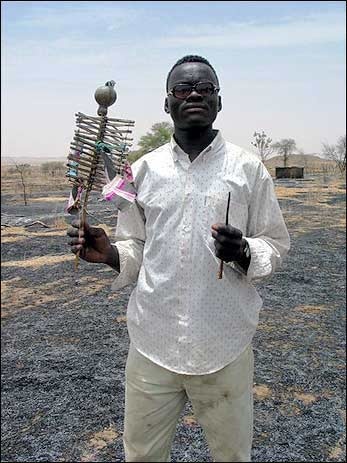
Ibrahim Adam holds the only two things left intact in the village, a metal stake used to tether his donkey, and the symbol of a recent wedding.
Ibrahim has no doubt who is to blame for his misery. "The Arabs," he said, adding that "all the Arabs are Janjaweed. I never want to see them."
The complicated reasons for the Darfur conflict - government versus rebels, so-called Arabs against African tribes - are intertwined with a battle for land and water. As the Sahara desert encroached ever further south, the Arabic nomads increasingly trespassed on the farms of settled African tribes and let their cattle and camels graze on the crops intended to keep the farmers' families alive.
Now Ibrahim points out the fresh cow patties dotted around the charred ruins of the village. "See - the Arabs have already brought their cows here," he said. They are to blame for the swarms of flies, though Ibrahim added, "perhaps there are dead bodies here too."
Widespread attacks on Darfur villages have ceased - largely because the countryside is empty, the former residents now caged in miserable camps around larger towns - but Seraf "shows how much work there still is to be done, starting with basic protection," said the UNHCR staff member.
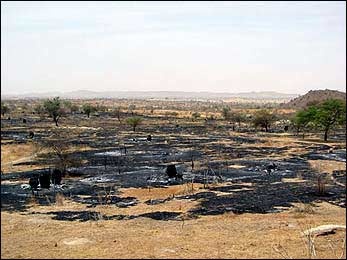
An aerial view shows that the entire village was burned.
As for Ibrahim, he's heard on the radio that the Africa Union is conducting talks aimed at peace in Darfur.
"There are great efforts going on," he acknowledged, standing in the ruins of his former house. "But still I feel unsafe to come back home."
By Kitty McKinsey in Seraf, Sudan


